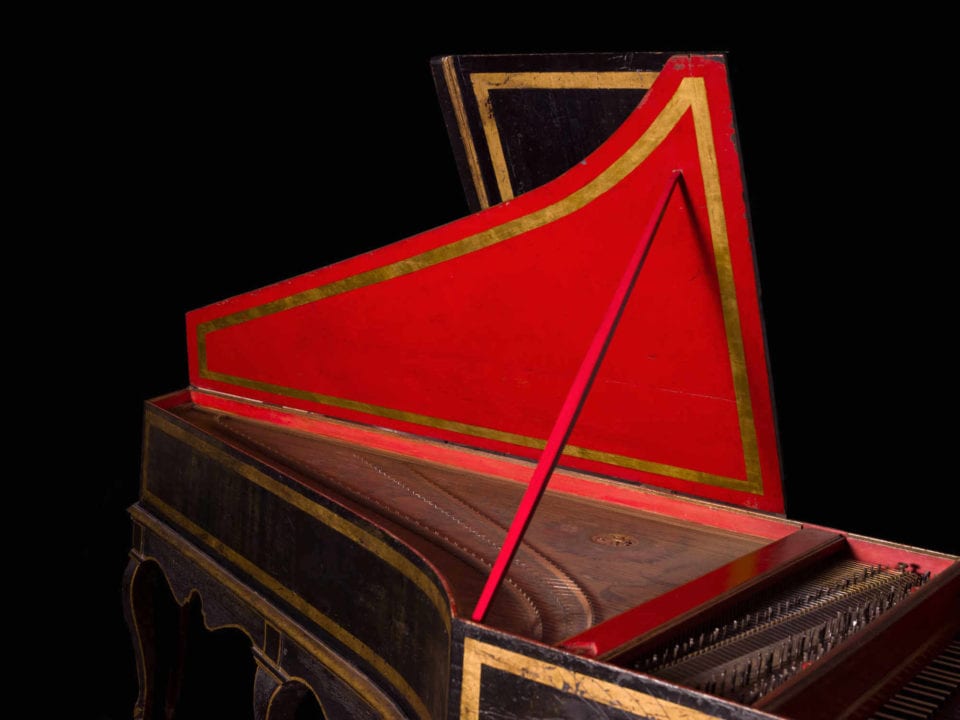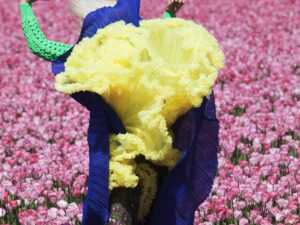Viviane Sassen’s (b. 1972) new series Venus & Mercury is inspired by accounts of the French royal court in the 17th and 18th centuries. The images bring visual histories into the present-day – juxtaposing period architecture with contemporary styling. The collection features three teenagers – Charline, Blanche and Leila – from the nearby town of Versailles, embracing one another against Baroque interiors. The works tap into themes of eroticism, power and intrigue through the female gaze, all whilst referencing royalty through reds, golds and blues. Nanda van den Berg, Curator at Huis Marseille, discusses the themes and legacy of Sassen whilst the show’s closed over the coming weeks.
A: This show comes eight years after In and Out of Fashion. How, in your eyes, has her work developed since then? How does this series differ from her previous series?
NV:In and Out of Fashion was the first time that Sassen put an exhibition and a book together to display all her work in fashion. She had never done that before. She looks at fashion as her “laboratory” – where ideas originate that she might later also use in her art. It was a really special occasion, because for this first show at Huis Marseille, many new processes were developed to exhibit the works, that – having originated in fashion – were meant to be experienced in a more ephemeral way compared to her other art.

To emphasise this, In and Out of Fashion saw the introduction of large unframed posters and a huge video projection, including a catwalk, mirrors and shadows, and that was very immersive. In later exhibitions that were shown in other museums – such as Umbra for the Nederlands Fotomuseum in Rotterdam – Sassen took further steps in developing new ways to create and exhibit her work. New use of her iconography – such as the enigmatic use of shadows, squares of coloured plexiglass, the inclusion of the visitor through his own projection on the screen: such were mediums and imagery that Sassen developed further and took to another level in her later art shows.
In the last couple of years, Sassen has begun to create unique pieces of art, by painting on photographs. For our collection, we acquired the 2018 work Vault, which features areas that were painted white on the photograph to elevate the sculptural qualities of the underlying image. But last year, Sassen took her artistic exploration of painting and photography – and the combination thereof – even further, especially in the Venus & Mercury series. Not only does she paint or draw on many of the images, or uses cut-outs in a previously unexplored way, she also uses the possibilities of the “mirroring” of images in an impressive, hypnotic way in her video-installation. In Venus & Mercury she introduced ever more new techniques, like a combination of neon and photography, or an installation of photography, projection and water. Sassen’s art is in a constant process of renewal, either in the choice of themes and imagery or in ways of treating and / or presenting the work.
A: The exhibition is split in two in many ways – between Venus and Mercury – what is the significance of these two strands? How have you responded to these in the curation / structuring of the show?
NV: The point of departure – Sassen’s inspiration for the show – is a set of stories that are divided over the two houses of Huis Marseille, each story getting their own space where it is getting translated/transformed into an installation. Venus & Mercury refers on the one side specifically to one room: / one story about “love” (Venus) and “medicine” (Mercury) – Mercury was seen as a cure for syphilis in the 18th and 19th century, which of course it did not cure at all. The saying “a night with Venus, a lifetime with Mercury” inspired Sassen for an installation for a specific room. On the other side, Venus & Mercury became the overall motive / inspiration of the exhibition as every story deals with or is influenced by the carnal aspects such as love, lust, decay, youth and death.
A: The images were inspired by accounts of the French Royal Court – how has Sassen played with ideas of portraiture, royalty and power in the images?
NV:Instead of literal references, Sassen was inspired by intuitive associations: the shape of a piano referring to a guillotine, for example. An entanglement of coloured “serpents” refers to homosexuality at the courts. The interplay of Versaille’s multi-cultural youth posing in the gilded rooms of the palace refer to a black daughter that was apparently born to a French queen and put in a nunnery. This exhibition is a very personal and artistic take on those histories and focuses on general human undercurrents that are beautifully captured in unique imagery.

A: How has this been translated into the contemporary moment with the youthful figures?
NV: By bringing hip young girls into the monumental palace rooms and photographing them in their contemporary clothes doing things young people (of all ages) do, Sassen emphasises the fact that there is only continuity in the eternal ways that people (or youth specifically) live and behave, and that there is no real caesura between now and then. History becomes fresh and vital and current by introducing multi-cultural youth in the context of those stones that built history.
A: The photographs are also accompanied by poetic texts by Marjolijn van Heemstra. How do these texts illuminate the visuals?
NV:Sassen invited van Heemstra to compose a poetic paragraph for every story in the exhibition; her texts are on the walls in vinyl lettering. The poem adds another layer – another artistic dimension – to the exhibition, and in this way, it is also a collaboration between artists. For the installation of some of these separate pieces in Grand Trianon in Versailles in 2019, the actress Tilda Swinton was asked to recite Van Heemstra’s poems for the audio / video installation. In Huis Marseille’s instalment this can also be heard in our large gallery.
A: The show also spills out into the gardens – how have you used the contrast between interiors and exteriors with these works? How have you incorporated the outdoors?
NV:Sassen curated this show specifically for the rooms and spaces of Huis Marseille. Actually, one cannot take it out of the context of our museum, as every story was tailor-made for a specific room. A few large pieces that formed four pillars of Sassen’s show in Grand Trianon in Versailles found new significance in very unexpected places in our museum, such as the light court and the garden. The extremely large piece that is now in the garden could not have been placed anywhere else in the museum (because of its size) and it is now visually bringing together the whole show, because when you look out of the windows at the back of our museum (which look out at the garden from every floor and every gallery), you see the image Man and Lion that makes you feel that all the separate stories are connected by its force and power.
A: What do you hope viewers take away from the show?
NV: I hope that they are touched to their core by the creative power of Viviane Sassen – her daring approach, continuous innovation and flawless judgment, as well as her intuitive storytelling. Her magnificent imagery is completely her own – it is unique in both its iconography and its approach, and I hope the viewers realise what an exceptional artist she is.
huismarseille.nl
vivianesassen.com
Credits:
1. Leïla, 2019 © Viviane Sassen.
2. Madame Victoire #01, 2019 © Viviane Sassen.
3. Blanche&Leïla, 2019 © Viviane Sassen.





